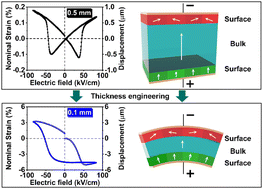Ultra-large electromechanical deformation in lead-free piezoceramics at reduced thickness†
Abstract
Lead-free piezoceramics with large controllable deformations are highly desirable for numerous energy converter applications ranging from consumer electronics to medical microrobots. Although several new classes of high-performance ferroelectrics have been discovered, a universal strategy to enable various piezoceramics to realize large electromechanical deformations is still lacking. Herein, by gradually reducing the thickness from 0.5 mm to 0.1 mm, we discover that a large nominal electrostrain of ∼11.49% can be achieved in thin 0.937(Bi0.5Na0.5)TiO3–0.063BaTiO3 (BNT–BT) ceramics with highly asymmetric strain–electric field curves. Further analyses of the polarization switching process reveal that the boosted strain curves originate from the bending deformation driven by asymmetric ferroelastic switching in the surface layers. Based on this, one monolayer BNT–BT was designed to realize digital displacement actuation and a scanning mirror application with a maximum mirror deflection angle of 44.38°. Moreover, the surface effect-induced bending deformation can be extended to other piezoceramics, accompanied by derived shape retention effects. These discoveries raise the possibility of utilizing thickness engineering to design large-displacement actuators and may accelerate the development of high-performance lead-free piezoceramics.



 Please wait while we load your content...
Please wait while we load your content...